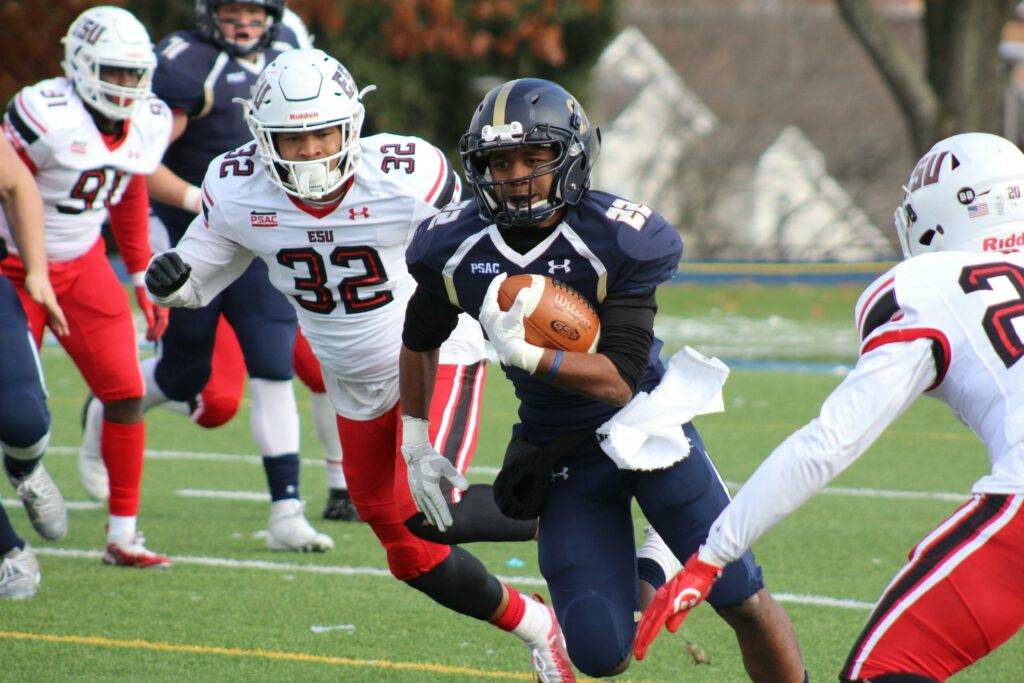Essential Guidelines for
Football Recruitment
How Do You Stack Up in College Football Recruiting?
Curious about how you compare to top Division 1 quarterbacks or linebackers? To help athletes and families gain clarity, we’ve analyzed data from NCAA, NAIA, and NJCAA football rosters over the past five years. These insights provide benchmarks on the height, weight, and skill sets college coaches typically look for based on position and division level. However, recruitment isn’t just about physical size.
Coaches assess recruits on a range of factors, including position-specific skills, game performance, and athletic achievements. Below, we break down the specific skill sets and accomplishments coaches look for, so you can better understand where you fit in the recruiting landscape.
How to Use Football Recruiting Guidelines
To assess your potential for college football, you must consider both the skill sets required for your position and your level of experience. Here’s why both matter:
Position-Specific Skills: Each position demands unique abilities. Quarterbacks need to master passing and decision-making, while running backs must excel in running, blocking, and catching. Defensive players must sharpen their tackling, coverage, and pass-rushing techniques. Focusing on position-specific skills helps you target areas for improvement.
Awards and Varsity Experience: Depending on the size and competitiveness of your school, these factors can vary. Athletes from smaller programs may need more accomplishments to stand out, while those from powerhouse schools can attract attention with fewer varsity years. Your high school coach can provide valuable insights into where your school and experience level stand.
These guidelines can serve as a tool to help you gauge which division level may be the best fit. While they won’t answer every question, they give you a solid framework to make informed decisions about your recruitment journey.
Insider Tip: Get Your Height and Weight Verified
College coaches place a premium on verified measurements, especially for height and weight. Verified stats add credibility to your profile, giving coaches confidence in your numbers. Attending a football combine, like the free Rivals adizero Combines, is one of the easiest ways to get your height and weight verified.
Position-Specific Football Recruiting Guidelines
Quarterback:
- NCAA Division 1 (FBS): A three-year varsity starter with All-State-level experience. Must have strong arm strength and be able to execute deep passes (e.g., out routes and comebacks) with accuracy and power.
- NCAA Division 1 (FCS): Similar requirements, but at the All-Conference level. Proficiency in throws like back-shoulder passes is a must.
- NCAA Division 2: A two-year varsity starter with All-Conference-level performance. Solid arm strength and the ability to complete difficult passes are essential.
- NCAA Division 3 and NAIA: At least one year as a varsity starter with the ability to make accurate medium and long-distance throws.
Running Back:
- NCAA Division 1 (FBS): A three-year varsity starter with All-State-level performance. Must showcase speed, power, balance, and the ability to break tackles and catch passes.
- NCAA Division 1 (FCS): A fast, tough runner at the All-State level. Ability to break through defenses and demonstrate quickness is key.
- NCAA Division 2: A two-year varsity starter with All-Conference-level performance. Must have good balance, instincts, and durability.
- NCAA Division 3 and NAIA: At least a one-year varsity starter with strong instincts, adequate speed, and the ability to block and catch from the backfield.
Wide Receiver:
- Speed, elusiveness, and excellent ball-handling are crucial. Top-tier receivers should be threats in every play, with proficiency in all types of routes.
Offensive Line:
- Physical dominance, pad level, and the ability to block in space are essential. Recruits must move the line of scrimmage effectively.
Defensive Line:
- Recruits must show strength and leverage in both run defense and pass rushing. Successful players dominate the line of scrimmage and pressure the quarterback.
Creating a Complete Recruiting Profile
By following these position-specific guidelines, you can get a clear sense of where to focus your training and development to attract the attention of college coaches. Combine these insights with your awards and varsity experience to create a complete recruiting profile that showcases your strengths and increases your chances of being recruited.


